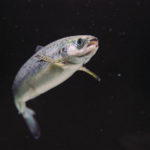
Just like in the picture on the left, salmon probably would like it best. With enough space and clean water.
There’s always a crowd in fish farming

The advantage of this crowd, the salmon are much easier to handle. During feeding or when the fish are caught. You don’t need huge plants, everything is compact together.
The disadvantage of this crowd, diseases or parasites like the salmon louse can spread much faster from animal to animal. Very often all animals in one tank or enclosure are affected in a short time.
Salmon louse is a big problem
Yeah, salmon have lice. The salmon louse is a parasite with the Latin name lepeophtheirus salmonis. This louse is not a new phenomenon, it was discovered almost 200 years ago. The difference to earlier times is the salmon lived in the sea and had a lot of space. Today, it lives together with thousands of other fish crowded into an aquaculture. Lice eggs can spread very quickly in such an environment and find new host fish. The louse docks to the fish skin and lives from the skin of the fish or its blood.
This is particularly dangerous and life-threatening for younger fishs.
Salmon lice impressed by Merus rings

Merus rings have been installed at the water supply of the fish tank and fish are observed how they develop in comparison to salmon in untreated water.
The result was very surprising for all involved. The salmon that benefited from Merus water had almost twice the survival rate compared to the fishn in the untreated tank. This means that the salmon with the treated water has much less infestation by lice.
An official study was not published. We don’t know the reason for this.
